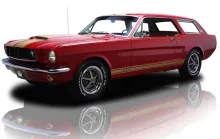Similar to the muscle car, the pony car had a big impact on a generation. The exact definition of a Pony Car is a small bodied vehicle with a large engine. Some examples are the Ford Mustang, Plymouth Barracuda, Chevrolet Camaro, Pontiac Firebird, Mercury Cougar, AMC Javelin, and Dodge Challenger.
Although the muscle car era was short-lived, it still defined a generation in America, and has given us possibly some of the most collectible cars in all of automotive history today. With the sharp lines, wide profiles, muscular looks, and chrome, these cars looked mean. Team the mid-sized bodied frame with a monster V8 engine, and these cars WERE mean. Mean fast! Some models that fit into the muscle car category are the Buick GS, Pontiac GTO, and the Dodge Charger.
Back in 2008 Barrett-Jackson touted their "Barrett-Jackson Mini-Index" had outperformed the Dow Jones, S&P 500, and even gold over the previous five years. Their data showed a 16.4% return for collector cars vs 4.0% (S&P 500), 5.1% (Dow Jones), and 11.2% (gold). The press release by Barrett-Jackson makes it seem like classic cars are true investment opportunities until you read the details. The models used in this index are:
1957 Ford Thunderbird
1967 Jaguar XKE
1967 Ford Mustang Shelby GT500
1970 Chevrolet Camaro Z/28
1970 Plymouth AAR ‘Cuda
1965 Austin Healy MK III
1967 Chevrolet Corvette 427/435

Like Jim Morrison himself, there are many legends and mysteries surrounding the history and whereabouts of his 1967 Mustang Shelby GT 500. Shelby fans have long sought after this car, with every few years reports surfacing of it being found, but the reports have never turned out to be true.

I stumbled upon RK Motors Charlotte (My favorite classic car dealership) selling a 1965 Ford Mustang Station Wagon a few months back, and it really peaked my curiosity. I knew from the top of my head that Ford has never officially built a Mustang station wagon, but I wanted to know more about the historical aspect of this unique car. But first let's talk about this model I found for sale, which was built off a Mustang wagon model actually built in 1965, and ties to the early history of the Mustang.

Hood scoops became a necessity on muscle cars of the 1960's and 1970's as the monster V8 engines powering these vehicles needed cooler air. Pontiac found early on that making the hood scoops functional and funneling cooler air to the carburetor gave a dramatic boost in power. Things just kept getting bigger after that.
Cooling the engine is not the only function of a hood scoop. The engine bay area is about 50 degrees warmer than the ambient temperature, so funneling cooler air from outside to the carburetor increases power. The colder air is, the more density it has which means more oxygen per unit of volume. More oxygen available means you can oxidise more fuel per combustion cycle, creating more power.
